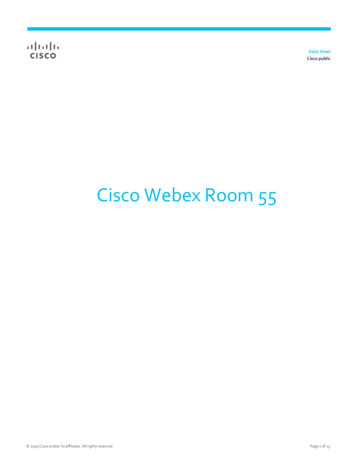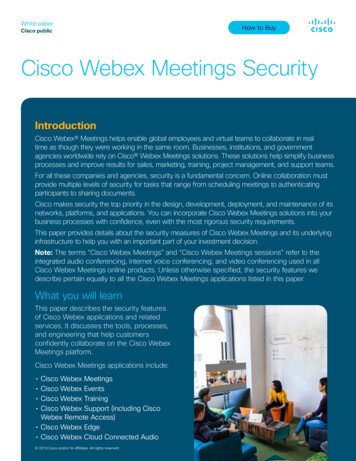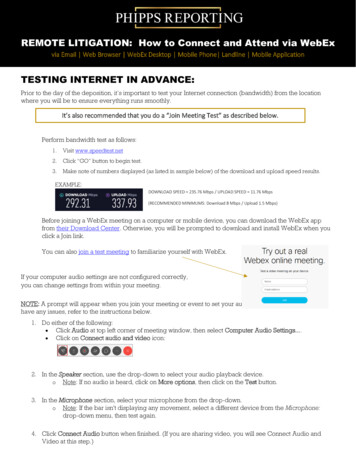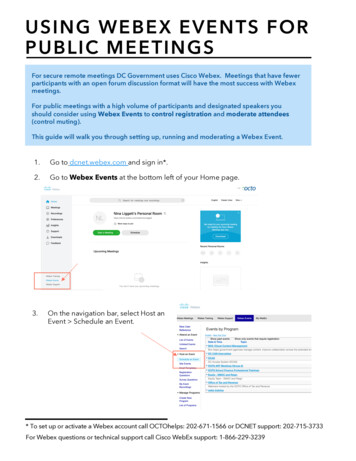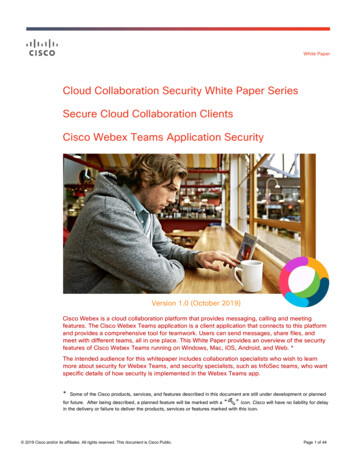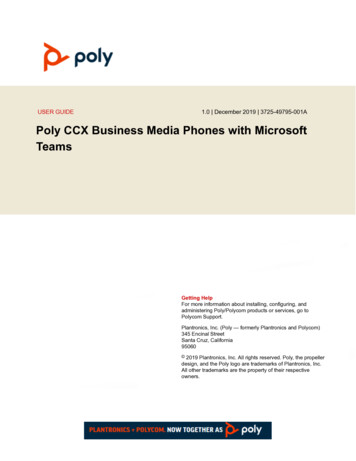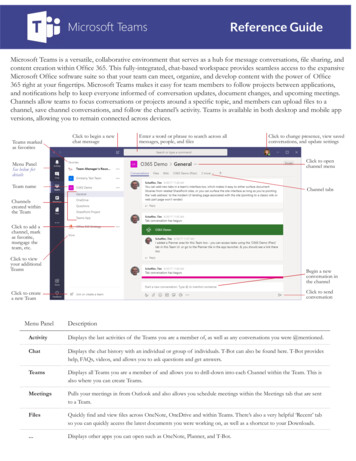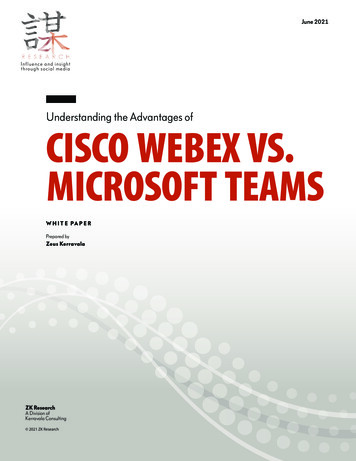
Transcription
June 2021Inf luence and insightthrough social mediaUnderstanding the Advantages ofCISCO WEBEX VS.MICROSOFT TEAMSW H I T E PA P E RPrepared byZeus KerravalaZK ResearchA Division ofKerravala Consulting 2021 ZK Research
ZK RESEARCH Understanding the AdvantagesZK RESEARCHof Cisco Webex Reportvs. MicrosoftTitle GoesTeamsHereINTRODUCTION: COLLABORATION IS NOW A BUSINESS IMPERATIVEABOUT THE AUTHORZeus Kerravala isthe founder andprincipal analyst withZK Research. Kerravalaprovides tactical adviceand strategic guidanceto help his clients in boththe current businessclimate and the longterm. He deliversresearch and insightto the followingconstituents: end-userIT and networkmanagers; vendorsof IT hardware,software and services;and members of theAs the pandemic illustrated in stark detail, remote collaboration is now a requirement for everybusiness. The results of the ZK Research 2020 Work-from-Anywhere Study showed that beforethe pandemic, 22% of employees worked remotely (Exhibit 1). That figure skyrocketed during thepandemic. But after restrictions ease, ZK Research expects that number to settle at 42%.As the world gradually gets back to something resembling “normal,” the need for collaborationwill not recede along with the pandemic. To accommodate a hybrid work environment in whichemployees work from a corporate location for a day or two and then work remotely for a few more,companies will have to implement collaboration tools that are resilient, flexible, high quality andhigh capacity.Collaboration devices—and especially how they integrate into a company’s environment andhow well they work together—will be the key to success. In addition, user experiences in a corporatesetting, on the road and in a remote location will need to be consistent. A vendor that tries to doeverything or build a walled garden around devices and access will not be able to serve the broadest assortment of enterprise needs.In addition, now that collaboration is so pervasive and mission critical across countless industriesand enterprise types, the ability for a solution to serve unique use cases that couldn’t have beendrawn up during the engineering phase will be an important consideration. And with the wallsbetween unified communications as a service (UCaaS) and contact center as a service (CCaaS)coming down, a solution that can work across both without a problem will succeed in unifying twoseemingly opposed technologies—one focused in and one focused out.Exhibit 1: Remote Work Will Continuefinancial communitylooking to invest inthe companies thathe covers.22%Pre–COVID-19remote workersVoice er42%Post–COVID-19remote workersZK Research 2020 Work-from-Anywhere StudyZK Research: A Division of Kerravala Consulting 2021 ZK Research28
ZK RESEARCH Understanding the Advantages of Cisco Webex vs. Microsoft TeamsCollaborationrequires aglobal cloudinfrastructurethat’s managedand optimizedfor real-timecommunication.With so much focus on collaboration tools, simple calling often gets shunted aside. But becauseit remains a mission-critical and universally accepted way to connect with customers, suppliers andco-workers, it should be integrated with a company’s collaboration system.The ability for collaboration tools to take advantage of artificial intelligence (AI) and other intelligent functions—which are maturing and making significant contributions to productivity, user experience and inclusivity—relies on coding specific to the collaboration platform itself, not just recycledgeneric code.Collaboration is now at the center of most enterprises, so it requires a global cloud infrastructure that’s managed and optimized for real-time communication. Plus, the vendor needs to have along-term vision of the future and how its collaboration solution fits into the overall digital enterprisewithout feeling locked into arbitrary standards, licenses or technologies.Two of the more widely adopted products are Cisco Webex and Microsoft Teams. In this report,ZK Research compares them and—using criteria on the new ways in which we work—evaluateswhether the solutions are up to today’s challenges.SECTION II: COMPARING COLLABORATION VENDORSSelecting a collaboration tool entails more than just finding the solution a company needs; thereare multiple dimensions to consider.Years ago, when collaboration tools were novel, typical evaluation criteria included basic features,such as the ability to share documents, make calls, message other team members and meet usingvideo. Nowadays, those capabilities are table stakes. If a vendor fails to check any of those boxes,companies should disregard them and move along.ZK Research has evaluated all of the mainstream collaboration tools, including two of the mostcommonly deployed: Cisco Webex and Microsoft Teams. Based on our evaluation, we believe CiscoWebex to have advantages over Microsoft Teams in several critical areas, including the following: eamless collaboration for users inside and outside the company: Every organizationSconducts business with external participants, such as partners, stakeholders and vendors. Connecting with each one, regardless of location, should be easy and secure from within the collaboration tools.I ntegrated software and hardware: Collaboration now happens regardless of location ordevice—it’s about more than just PC-based meetings. Although people still meet in conferencerooms, they also participate from the road, use external cameras and use whiteboards. They alsostart calls on desk phones and then move to mobile phones and/or to laptops. The hardware andsoftware must account for these devices and provide a single, cohesive experience. As peoplereturn to work, the use of video will remain heavy, and integrated experiences will maximizeworker productivity.ZK Research: A Division of Kerravala Consulting 2021 ZK Research38
ZK RESEARCH Understanding the Advantages of Cisco Webex vs. Microsoft Teams nterprise calling: Although many meetings are video based, calling is still a business-criticalEfeature. The experience must be world class and match users’ expectations for calling in otherenvironments. Doing just an adequate job with something as fundamental as calling won’t begood enough for today’s enterprise customers.When it comes tocollaboration, onesize certainly doesnot fit all. bility to embed in existing applications: Standalone meeting apps are okay for general colAlaboration. But in today’s enterprises, numerous processes require the use of other applicationsin conjunction with collaboration tools. An isolated application won’t make the grade in these usecases; it’s far more effective to embed collaboration functions into existing apps. The ability tointegrate into applications is critical in specific verticals such as healthcare, government, financial services and education. single interface to manage and support users: Users have always been separated by timeAand distance, scattered in locations around the globe. Now, with workers even more distributedacross corporate settings, home offices, remote locations, hotels and other locations, managingcollaboration tools is a particularly acute challenge. Having separate management tools createsblind spots that can reduce efficiency and lead to security issues. Therefore, any modern collaboration tool should have a single dashboard to ensure simple management. focus on employee and customer experiences: When it comes to collaboration, one sizeAcertainly does not fit all. Consider the scale of meetings a company needs: a meeting with threeparticipants is much different from one with 50 or 250. Plus, the needs of the host and theattendees are distinct, so vendors should be able to address these differences. In addition, because some industries have security concerns and must control access, it’s important to be ableto do so easily. And with a diverse workforce, it’s critical to create experiences that are inclusiveof all workers.SECTION III: COMPARING CISCO WEBEX AND MICROSOFT TEAMSThinking about the criteria outlined in the previous section, how do Cisco Webex and MicrosoftTeams compare? The tables in this section detail each element, including seamless collaboration,integrated software and hardware, enterprise calling, embedding in applications, user support andspecialized experiences.ZK Research: A Division of Kerravala Consulting 2021 ZK Research84
ZK RESEARCH Understanding the Advantages of Cisco Webex vs. Microsoft TeamsZK Research: A Division of Kerravala Consulting 2021 ZK Research58
ZK RESEARCH Understanding the Advantages of Cisco Webex vs. Microsoft TeamsZK Research: A Division of Kerravala Consulting 2021 ZK Research68
ZK RESEARCH Understanding the Advantages of Cisco Webex vs. Microsoft TeamsAdditional Points About Cisco Webex’s Collaboration LeadershipThere are a few areas not covered in the preceding tables that also underscore Cisco’s leadership: rice: Cisco’s pricing is straightforward, while Microsoft’s is not transparent because of the wayPMicrosoft 365 is bundled and the tendency for those costs to creep up. roduct focus: The founding DNA of Cisco was (and always will be) real-time communicaPtions and networking. It’s where the company’s credentials and expertise reside, and thatfocus shines through in Webex. Microsoft has a different focus—productivity—and that showsin Teams. edigree: Cisco’s expertise in networking and optimization is evident in the quality of Webex’sPbackbone; it was built for real-time communication. In contrast, Microsoft lacks this pedigree. ecurity: Cisco’s security capabilities were developed in house and built into Webex. By marSket share, Cisco is the top enterprise security vendor, and it applies that knowledge to Webex—while security has always been an afterthought for Microsoft. nalytics: Both Cisco and Microsoft have built analytics dashboards and track activity,Abut they use the data in vastly different ways. With Teams, the data is used to essentially letmanagers spy on employee activity. In fact, the data is viewed as being so intrusive that ZDNetrecently published an article titled “I looked at all the ways Microsoft Teams tracks users, andmy head is spinning” that highlights just how little privacy Teams provides to workers. Conversely, Cisco tracks data to provide user feedback on how to work more efficiently. Cisco hasalways put employee privacy first, and it provides “Personal Insight” that can only be viewed byZK Research: A Division of Kerravala Consulting 2021 ZK Research78
ZK RESEARCH Understanding the Advantages of Cisco Webex vs. Microsoft Teamsthe employee. The data can be used to help workers manage their meetings more efficientlyand reduce some of the meeting fatigue people are experiencing.In addition, Cisco Webex’s market share is impressive. According to Synergy, in 2020, Ciscohad a larger collaboration installed base than any other company (Exhibit 2). With 40.2% of themarket, Cisco handily beat Zoom (at 32.8%) and was four times the size of Microsoft (at 10.1%).This gives Cisco a distinct advantage, as its massive customer base provides a continual feedbackloop for product updates and enhancements.It’s important to understand that this is not an exhaustive list of all features and functions;Microsoft does have advantages in the area of integration with other Microsoft products. Butcompanies that have requirements around collaborating with external users, integrated hardwareand software experiences, enterprise calling, integration with applications, a single managementexperience, and specialized experiences will find Webex to be the better choice.SECTION IV: CONCLUSION AND RECOMMENDATIONSAfter carefully reviewing Cisco Webex and Microsoft Teams, ZK Research found that Teamspales in comparison to Webex with regard to the breadth and depth of capabilities, particularly inthe areas noted earlier—even though Teams is a viable product and Microsoft has made advancements to it in recent years.Exhibit 2: Cisco Webex Has the Largest Collaboration Installed BaseV-cubeRest of 32.8%ZoomNote: Total does not equal 100% due to rounding.Synergy and ZK Research, 2020ZK Research: A Division of Kerravala Consulting 2021 ZK Research8
ZK RESEARCH Understanding the Advantages of Cisco Webex vs. Microsoft TeamsBecause every enterprise’s needs are different, ZK Research offers the following recommendationsfor evaluating collaboration solutions: Find a product that enables collaboration with people outside of your organization. Look for well-integrated software and hardware. Make specialized use cases and adjacent applications—including cloud contact center,large event support and audience engagement—part of the solution. Seek a solution that handles fully featured enterprise calling, which is still a businesscritical feature. Insist on a solution that can easily be embedded into existing applications, which will makecollaboration easier and more commonplace. Ensure the solution has a single interface to help manage and support your users. Consider a solution that can scale to your organization, control access as needed andaccommodate a wide range of employee needs. Ensure the solution addresses the needs of all workers regardless of their technical aptitude,whether they require accommodations in order to perform their job, or any other factor thatmay limit inclusiveness.CONTACTzeus@zkresearch.comCell: 301-775-7447Office: 978-252-5314 2021 ZK Research:A Division of Kerravala ConsultingAll rights reserved. Reproductionor redistribution in any form withoutthe express prior permission ofZK Research is expressly prohibited.For questions, comments or furtherinformation, email zeus@zkresearch.com.ZK Research: A Division of Kerravala Consulting 2021 ZK Research98
After carefully reviewing Cisco Webex and Microsoft Teams, ZK Research found that Teams pales in comparison to Webex with regard to the breadth and depth of capabilities, particularly in the areas noted earlier—even though Teams is a viable product an

